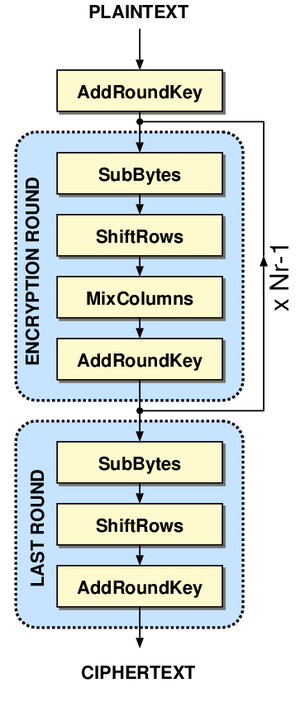| As of August 2020 the site you are on (wiki.newae.com) is deprecated, and content is now at rtfm.newae.com. |
Difference between revisions of "Tutorial CW305-2 Breaking AES on FPGA"
(→Theoretical Background) |
(→Theoretical Background) |
||
| Line 8: | Line 8: | ||
In our case, let's suppose that every round of AES is completed in a single clock cycle. Recall the execution of AES: | In our case, let's suppose that every round of AES is completed in a single clock cycle. Recall the execution of AES: | ||
| − | [[File:AES_Encryption.png| | + | [[File:AES_Encryption.png|300px]] |
Here, every blue block is executed in one clock cycle. This means that an excellent candidate for a CPA attack is the difference between the input and output of the final round. It is likely that this state is stored in a port that is updated every round, so we expect that the Hamming distance between the round input and output is the most important factor on the power consumption. Also, the last round is the easiest to attack because it has no MixColumns operation. We'll use this Hamming distance as the target in our CPA attack. | Here, every blue block is executed in one clock cycle. This means that an excellent candidate for a CPA attack is the difference between the input and output of the final round. It is likely that this state is stored in a port that is updated every round, so we expect that the Hamming distance between the round input and output is the most important factor on the power consumption. Also, the last round is the easiest to attack because it has no MixColumns operation. We'll use this Hamming distance as the target in our CPA attack. | ||
Revision as of 13:13, 16 January 2017
This tutorial is a continuation from Tutorial CW305-1 Building a Project. Here, we'll use our hardware setup to find a fixed secret key that the Artix FPGA is using for AES encryption. This tutorial relies on previous knowledge from Tutorial B5 Breaking AES (Straightforward), so make sure you know how that attack works.
Theoretical Background
During this tutorial, we'll be working with a hardware AES implementation. This type of attack can be much more difficult than a software AES attack. In the software AES attacks, we needed hundreds or thousands of clock cycles to capture the algorithm's full execution. In contrast, a hardware AES implementation may have a variety of speeds. Depending on the performance of the hardware, a whole spectrum of execution speeds can be achieved by executing many operations in a single clock cycle. It is theoretically possible to execute the entire AES encryption in a single cycle, given enough hardware space and provided that the clock is not too fast. Most hardware accelerators are designed to complete one round or one large part of a round in a single cycle.
This fast execution may cause problems with a regular CPA attack. In software, we found that it was easy to search for the outputs of the s-boxes because these values would need to be loaded from memory onto a high-capacitance data bus. This is not necessarily true on an FPGA, where the output of the s-boxes may be directly fed into the next stage of the algorithm. In general, we may need some more knowledge of the hardware implementation to successfully complete an attack.
In our case, let's suppose that every round of AES is completed in a single clock cycle. Recall the execution of AES:
Here, every blue block is executed in one clock cycle. This means that an excellent candidate for a CPA attack is the difference between the input and output of the final round. It is likely that this state is stored in a port that is updated every round, so we expect that the Hamming distance between the round input and output is the most important factor on the power consumption. Also, the last round is the easiest to attack because it has no MixColumns operation. We'll use this Hamming distance as the target in our CPA attack.
Capture Setup
- Reference last tutorial - Mention what the default settings are - Look at one trace (especially for the length) - Explain that there's little leakage - Set up for 5000 traces - Capture many
Analysis
- Load project - Most default settings are fine - Change leakage to HD - Results
